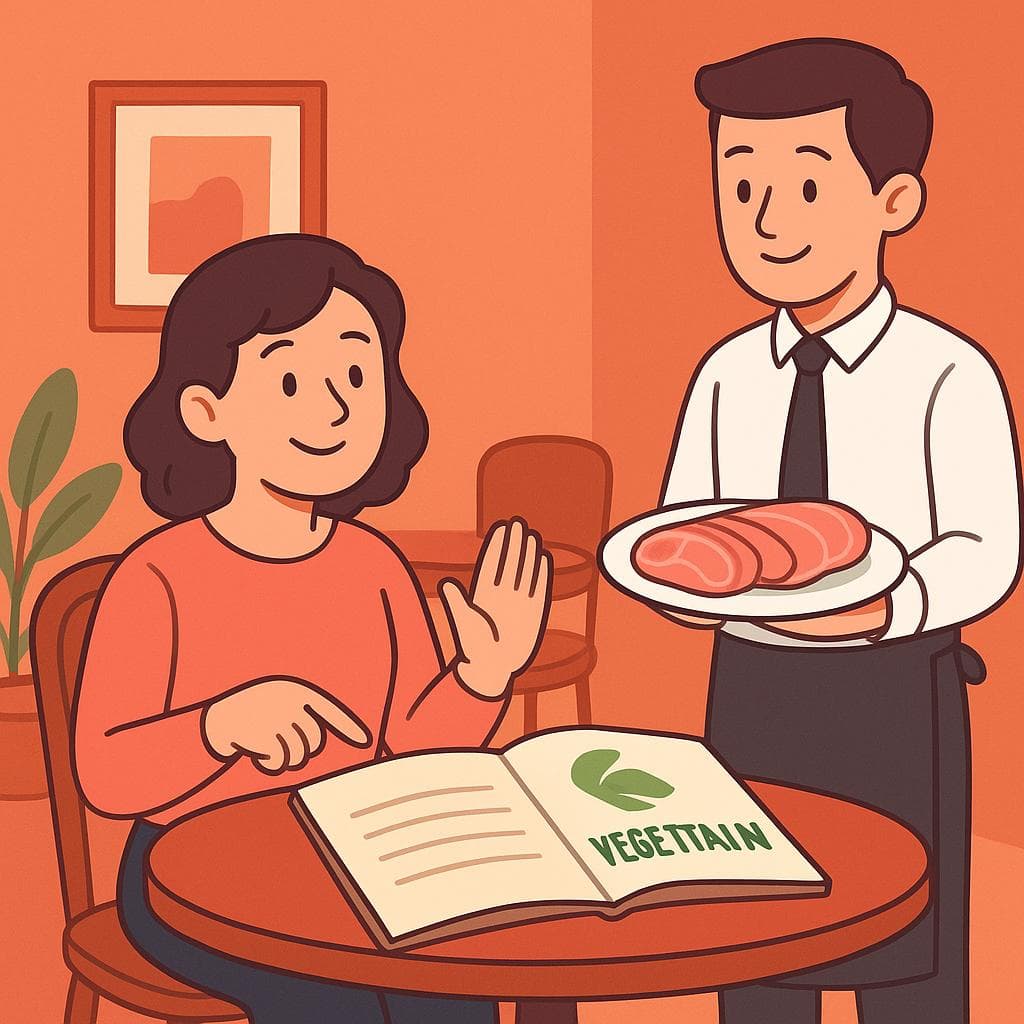I don't eat pork
in SpanishNo como cerdo
/noh KOH-moh SEHR-doh/
The most standard, universally understood way to state you don't eat pork. It works in any Spanish-speaking country, though the specific word for 'pork' might vary by region.

Politely declining a dish by saying 'No como cerdo' is the best way to stick to your diet while dining out.
💬Other Ways to Say It
No como puerco
/noh KOH-moh PWEHR-koh/
The most common way to say it in Mexico and the Caribbean. While 'cerdo' is understood, 'puerco' is the everyday word for the meat in these regions.
No como chancho
/noh KOH-moh CHAHN-choh/
A very common regional variation in South America, particularly in the Andean regions and the Southern Cone.
No como carne de cerdo
/noh KOH-moh KAHR-neh deh SEHR-doh/
A slightly more specific way to say 'I don't eat pork meat.' It sounds a bit more formal and precise.
Soy alérgico al cerdo
/soy ah-LEHR-hee-koh ahl SEHR-doh/
Means 'I am allergic to pork' (masculine speaker). Use 'alérgica' if you are female.
Por motivos religiosos, no como cerdo
/por moh-TEE-vohs reh-lee-HYOH-sohs noh KOH-moh SEHR-doh/
Explicitly states 'For religious reasons, I don't eat pork.'
🔑Key Words
Key Words to learn:
📊Quick Comparison
Different ways to express dietary restrictions regarding pork based on the situation.
| Phrase | Formality | Best For | Avoid When |
|---|---|---|---|
| No como cerdo | Neutral | General use, restaurants, casual conversation | You have a severe life-threatening allergy (be more specific) |
| Soy alérgico al cerdo | Neutral/Serious | Medical necessities, ensuring no cross-contamination | It's just a preference (don't scare the chef unnecessarily) |
| No como carne | Neutral | Vegetarians | You eat chicken or beef but just avoid pork |
📈Difficulty Level
Standard pronunciation is easy. The main challenge is remembering the regional word (cerdo vs. puerco vs. chancho).
Very simple structure: 'No' + verb 'como' + noun.
Pork is deeply embedded in Hispanic cuisine. Avoiding it requires vigilance regarding lard (manteca) and garnishes.
Key Challenges:
- Remembering to ask about lard (manteca)
- Knowing which regional word to use
💡Examples in Action
Disculpe, ¿esto lleva cerdo? Es que no como cerdo.
Excuse me, does this have pork? It's just that I don't eat pork.
Lo siento, no puedo comer eso. No como puerco.
I'm sorry, I can't eat that. I don't eat pork.
Por favor, asegúrese de que los frijoles no tengan manteca. No como chancho.
Please make sure the beans don't have lard. I don't eat pork.
🌍Cultural Context
The 'Hidden' Pork: Manteca
In many Hispanic cultures, especially in Mexico and Central America, beans (frijoles) and tamales are traditionally cooked with 'manteca' (pork lard) for flavor. Even if a dish looks vegetarian, you should specifically ask, '¿Lleva manteca?' (Does it contain lard?) to be safe.
Pork is King in Spain
In Spain, cured ham ('jamón serrano' or 'jamón ibérico') is a cultural treasure and served almost everywhere. It is sometimes used as a garnish on dishes like peas, mushrooms, or soups that might otherwise seem vegetarian. Always double-check ingredients in Spain.
Hospitality and Refusal
Refusing food can sometimes be seen as rude in Latin American culture. If you are at a family home, it helps to soften the refusal by emphasizing that the food looks delicious ('se ve delicioso') but you *cannot* eat it due to your diet, rather than simply saying 'no'.
❌ Common Pitfalls
Assuming 'Sin Carne' covers pork
Mistake: "Asking for a dish 'sin carne' (without meat) and expecting no pork products."
Correction: Specifically say 'sin cerdo' or 'sin jamón' (without ham).
Mixing up animal names
Mistake: "Using 'cerdo' in a region where 'chancho' is the norm, or vice versa."
Correction: Listen to locals, but know that 'cerdo' is the safe, standard word everywhere.
💡Pro Tips
The 'Sin' (Without) Technique
When ordering, it's often easier to simply order the dish 'sin cerdo' (without pork) or 'sin jamón' (without ham) rather than explaining your whole diet. For example: 'Una ensalada, pero sin jamón, por favor' (A salad, but without ham, please).
Check the Chorizo
Chorizo is a very common spicy sausage made of pork. If you see 'chorizo' on the menu, assume it is pork unless specified as 'chorizo vegano' or 'chorizo de res' (beef chorizo), which is much rarer.
🗺️Regional Variations
Spain
In Spain, the 'c' in 'cerdo' is pronounced with a 'th' sound (like 'think'). Pork is ubiquitous here, especially cured ham. You must be very explicit that you don't want ham garnish on salads or soups.
Mexico
'Puerco' is the most common term for the food. The biggest hidden danger here is 'frijoles' (beans) which are frequently refried in lard (manteca de puerco). Always ask: '¿Los frijoles tienen manteca?'
Andean Region (Peru, Bolivia, Ecuador)
'Chancho' is the standard word for pig/pork here. Pork is very popular in dishes like 'chicharrón' (fried pork chunks, different from the Mexican skin version).
Caribbean (Cuba, PR, DR)
Roast pork (lechón) is the national obsession in many of these islands, especially for holidays. 'Puerco' is the standard term.
💬What Comes Next?
The waiter asks if ham is okay instead
¿Pero jamón sí come?
But do you eat ham? (Some assume ham is different from pork meat)
No, tampoco como jamón.
No, I don't eat ham either.
Checking for hidden ingredients
Solo tiene un poco de sabor.
It just has a little bit for flavor (referring to lard/bacon fat).
Prefiero evitarlo por completo, por favor.
I prefer to avoid it completely, please.
🔄How It Differs from English
In English, we have distinct words for the animal ('pig') and the meat ('pork'). In Spanish, the word is often the same (e.g., 'cerdo' is both the animal and the meat), though you can clarify by saying 'carne de cerdo' (meat of the pig).
False Friends & Common Confusions:
Why it's different: Calling a person a 'cerdo', 'puerco', or 'chancho' is a common insult meaning they are dirty or rude. Be careful to only use these words in the context of food or the animal itself.
Use instead: Use these words only when ordering food or pointing at the animal.
🎯Your Learning Path
➡️ Learn Next:
How to ask 'Does this have...?'
Essential for asking about specific ingredients like lard or ham.
How to say 'I am vegetarian'
A broader phrase that covers pork and might be easier to use in some contexts.
How to say 'It was delicious'
Useful for complimenting the food you *can* eat.
✏️Test Your Knowledge
💡 Quick Quiz: I don't eat pork
Question 1 of 3
You are in Mexico and want to ask if the beans are vegetarian. What is the most important question to ask?
Frequently Asked Questions
Is 'puerco' a bad word?
Not when talking about food. While calling a person a 'puerco' is an insult (meaning they are dirty), using it to order 'carne de puerco' in a restaurant is perfectly normal and standard, especially in Mexico and the Caribbean.
What if I just say 'no como carne' (I don't eat meat)?
This usually works, but be careful. In some traditional contexts, 'carne' implies beef. A server might still think chicken or ham is okay. It is safer to be specific or say 'soy vegetariano' (I am vegetarian) if you eat no meat at all.
How do I ask if a soup has pork broth?
You can ask: '¿El caldo es de pollo o de cerdo?' (Is the broth chicken or pork?) or '¿La sopa lleva hueso de jamón?' (Does the soup have ham bone?). In Spain, many vegetable soups use ham bone for flavor.
What is 'carnitas'?
'Carnitas' is a very popular Mexican dish made of slow-cooked pork. If you don't eat pork, you should definitely avoid anything labeled 'carnitas'.
📚Continue Learning Spanish Phrases
Explore More Phrases in These Categories
Find similar phrases to expand your Spanish vocabulary:
Want to Learn More Spanish Phrases?
Browse our complete collection of Spanish phrases organized by situation, from basic greetings to advanced conversations. Perfect for travelers, students, and anyone learning Spanish.
View All Spanish Phrases →